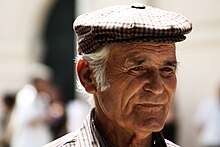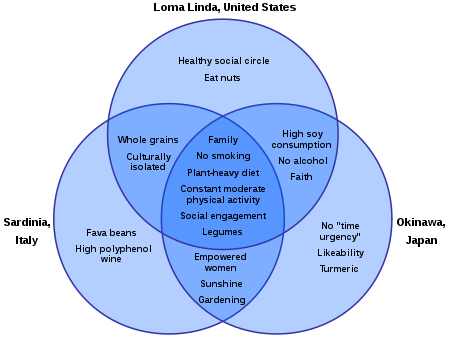Blue zone (demography)
Blue zones are regions of the world that Dan Buettner claims people live much longer than average. The term first appeared in National Geographic magazine in November 2005 in the cover story "The Secrets of a Long Life" by Buettner. Buettner identified five regions that he regards as "Blue Zones": Okinawa ( Japan ), Sardinia ( Italy ), the Nicoya Peninsula ( Costa Rica ), Ikaria ( Greece ) and among Seventh-day Adventists in Loma Linda , California . He gives an explanation, based on first-hand data and observations, why these populations are living healthier and longer lives. Dan Buettner had the English term "Blue Zones" protected .
Based on research results in the fields of biogerontology , epigenetics and naturopathy , the term “blue zones” is also used for areas whose native flora grows under special conditions and can effectively counteract the aging process. Such mostly high-altitude areas can be found in Nepal , Bhutan , Tibet or China . The Swiss research group Bluezones in collaboration with the Haslberger research group at the University of Vienna focus on secondary plant substances from areas that could be of use in the field of anti-aging , neurodegenerative diseases and diseases of the elderly . As early as 1998, the Swiss group dealt with the eating habits of the population of Yuzurihara, where the residents are getting very old with the best quality of life. Longevity regions are also being investigated in China over time. Another research group from the University of California in collaboration with the University of Rome La Sapienza is studying Bluezones areas in Italy which are outside of Sardinia. The term “BlueZones” in Europe has been protected by System Biologie AG of the Bluezones research group in the areas of active ingredients, food supplements and cosmetics.
The concept arose from the demographic work of Gianni Pes and Michel Poulain , described in the Journal of Experimental Gerontology , who identified the province of Nuoro in Sardinia as the region with the highest concentration of male centenarians . As the two men headed for the group of villages with the highest longevity, they drew concentric blue circles on the map and began to label the area within the circle as the Blue Zone. Together with demographers Pes and Poulain, Buettner expanded the term and applied it to validated longevity areas in Okinawa, Japan, and among Seventh-day Adventists in Loma Linda, California. Buettner and Poulain, led by National Geographic, then identified and validated longevity hotspots in Nicoya, Costa Rica and Ikaria, Greece.
Zones
The five regions in Buettner's book The Blue Zones: Lessons for Living Longer from the People Who've Lived the Longest are:

- Sardinia , Italy (specifically Ogliastra , Barbagia by Ollolai, and Barbagia by Seulo ): a team of demographers found a hotspot of longevity in mountain villages where a significant proportion of men are 100 years old. In particular, a village called Seulo , located in the Barbagia of Seulo, held the record of 20 centenarians from 1996 to 2016, confirming that it is "the place where people have lived the longest in the world".
- Okinawa Islands , Japan : Another team studied a group that is among the longest living on earth.
- Loma Linda , California : Researchers studied a group of Seventh-day Adventists who are among the longest living people in North America .
- Nicoya Peninsula , Costa Rica : The peninsula was the subject of research on a Quest Network expedition that began on January 29, 2007.
- Ikaria , Greece : A study from April 2009 on the island of Ikaria found the location with the highest percentage of 90-year-olds in the world - almost one in three makes it into the 1990s. In addition, beekeepers have "about 20 percent lower cancer rates, 50 percent lower rates of heart disease and almost no dementia".
Residents of these places produce a high rate of centenarians, suffer a fraction of the diseases that frequently kill people in other parts of the developed world, and enjoy more years of good health.
features
People in the Blue Zones share common lifestyle traits that contribute to their longevity. The Venn diagram on the right shows the following six common characteristics of the people of Okinawa, Sardinia, and the Blue Zones of Loma Linda:
- Family - more important than other concerns
- Smoke less
- Semi-vegetarianism - most of the food consumed comes from plants.
- Constant moderate physical activity - an inseparable part of life.
- Social commitment - people of all ages are socially active and integrated into their communities.
- Legumes - commonly consumed
In his book, Buettner offers a list of nine lessons covering the lifestyle of the people in the blue zones:
- Moderate, regular physical activity .
- Purpose of life.
- Stress relief .
- Moderate calorie intake .
- Plant-based nutrition .
- Moderate alcohol consumption; mostly wine.
- Engagement in spirituality or religion .
- Commitment in family life.
- Commitment in social life.
Alternative explanation
A study published in 2019 by Australian scientist Saul Justin Newman suggests that blue zones are actually created through fraud or insufficient documentation. For example, it can be observed in various states in the USA that since the introduction of birth registers (i.e. an objective measurement of age) the number of people who are supposedly over centenarians has fallen by more than two thirds.
See also
bibliography
- Dan Buettner: The Blue Zones, Second Edition: 9 Lessons for Living Longer From the People Who've Lived the Longest . National Geographic, Washington, DC 2012, ISBN 978-1-4262-0948-2 .
- Dan Buettner: Thrive: finding happiness the Blue Zones way . National Geographic, Washington, DC 2010, ISBN 978-1-4262-0515-6 .
Web links
Individual evidence
- ^ Longevity, The Secrets of Long Life - National Geographic Magazine . In: ngm.nationalgeographic.com . Retrieved April 3, 2017.
- ↑ This Adventurer Discovered The Secrets To Long Life - And It Could Save Iowa $ 16 Billion By 2016 . In: Business Insider . Retrieved November 5, 2018.
- ^ Blue Zones. Retrieved May 24, 2019 .
- ↑ Research Group Blue Zones. Retrieved June 3, 2019 .
- ^ Haslberger research group. Retrieved June 3, 2019 .
- ^ Y. Huang, G. Mark Jacquez: Identification of a Blue Zone in a Typical Chinese Longevity Region. In: International Journal of Environmental Research and Public Health. Volume 14, number 6, 05 2017, p., Doi : 10.3390 / ijerph14060571 , PMID 28555035 , PMC 5486257 (free full text).
- ^ A b Remote Italian Village Could Harbor Secrets of Healthy Aging. Retrieved June 3, 2019 .
- ^ Blue Zones. Retrieved June 3, 2019 .
- ^ Poulain M .: Identification of a Geographic Area Characterized by Extreme Longevity in the Sardinia Island: the AKEA study . In: Experimental Gerontology . 39, No. 9, 2004, pp. 1423-1429. doi : 10.1016 / j.exger.2004.06.016 . PMID 15489066 .
- ^ Poulain: Identification of a geographic area characterized by extreme longevity in the Sardinia island: the AKEA study . In: Experimental Gerontology . 39, No. 9, September, pp. 1423-1429. doi : 10.1016 / j.exger.2004.06.016 .
- ^ A b c d e f Dan Buettner: The Blue Zones: Lessons for Living Longer from the People Who've Lived the Longest . National Geographic Society, 2009, ISBN 978-1-4262-0400-5 (English, limited preview in Google Book Search).
- ↑ Seulo, il paese più longevo del mondo Soprannomi e segreti del paese dei record - Cronaca - L'Unione Sarda.it . In: L'Unione Sarda.it , April 3, 2016. Accessed November 27, 2016.
- ^ Gary Tuchman Anderson Cooper: CNN Transcripts on Living Longer . In: CNN . November 16, 2005. Retrieved August 25, 2006.
- ^ Nicoya, Costa Rica . BlueZones.com. Retrieved March 4, 2011.
- ^ Dan Buettner : Report from the 'Blue Zone': Why Do People Live Long in Costa Rica? . In: ABC News , February 2, 2007. Retrieved March 4, 2011.
- ↑ The Island Where People Live Longer , NPR: Weekend Edition Saturday, May 2, 2009
- ^ Dan Buettner: The Secrets of Long Life. S 9
- ^ Power 9 ™ - Blue Zones - Live Longer, Better : Blue Zones - Live Longer, Better , Quest Network, 2006.
- ^ Dan Buettner: The Blue Zones, Second Edition: 9 Lessons for Living Longer From the People Who've Lived the Longest . National Geographic Books, 2012, ISBN 978-1-4262-0949-9 (English, limited preview in Google Book Search).
- ^ Saul Justin Newman: Supercentenarians and the oldest-old are concentrated into regions with no birth certificates and short lifespans . In: bioRxiv . July 16, 2019, doi : 10.1101 / 704080 .
